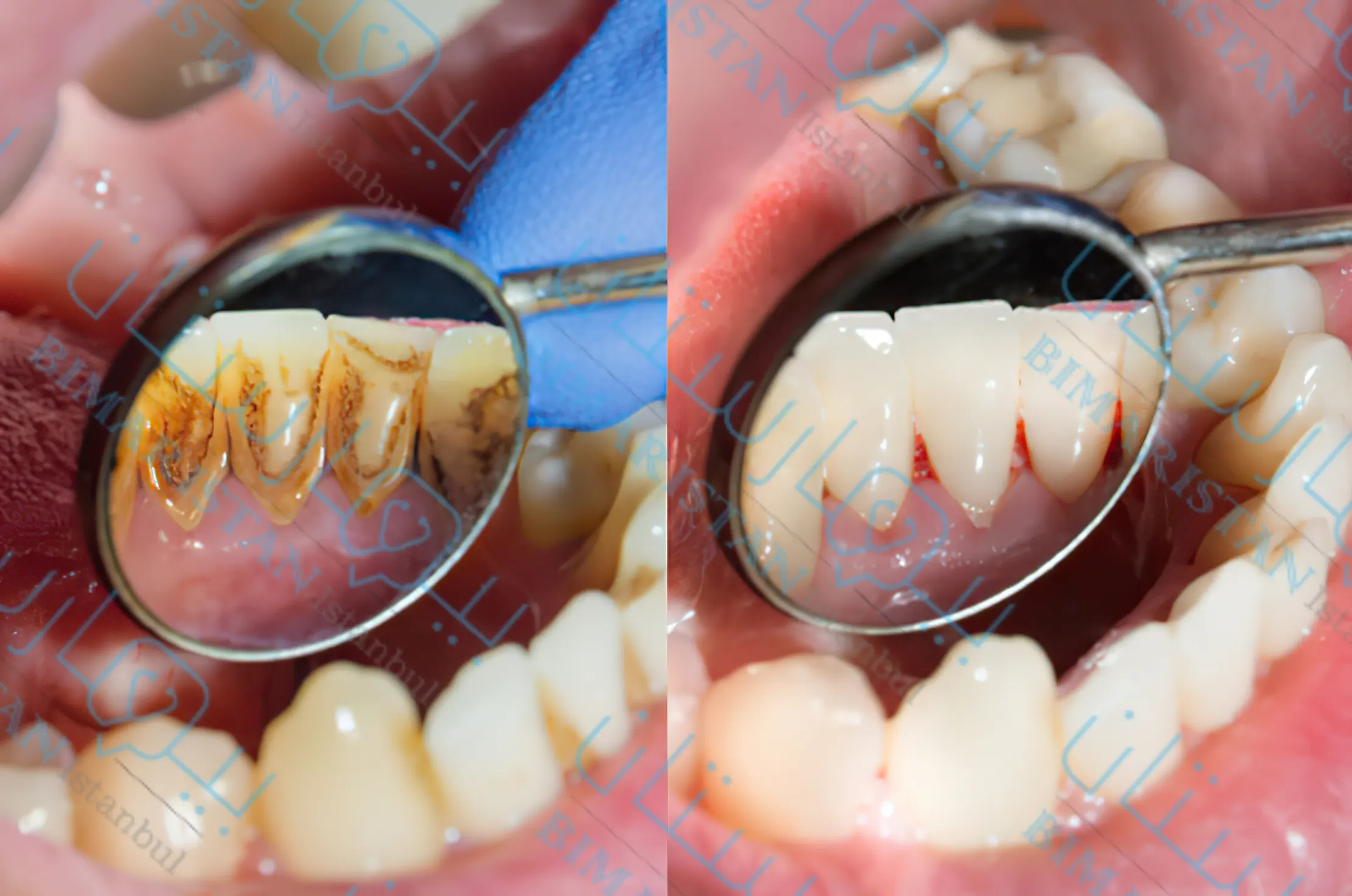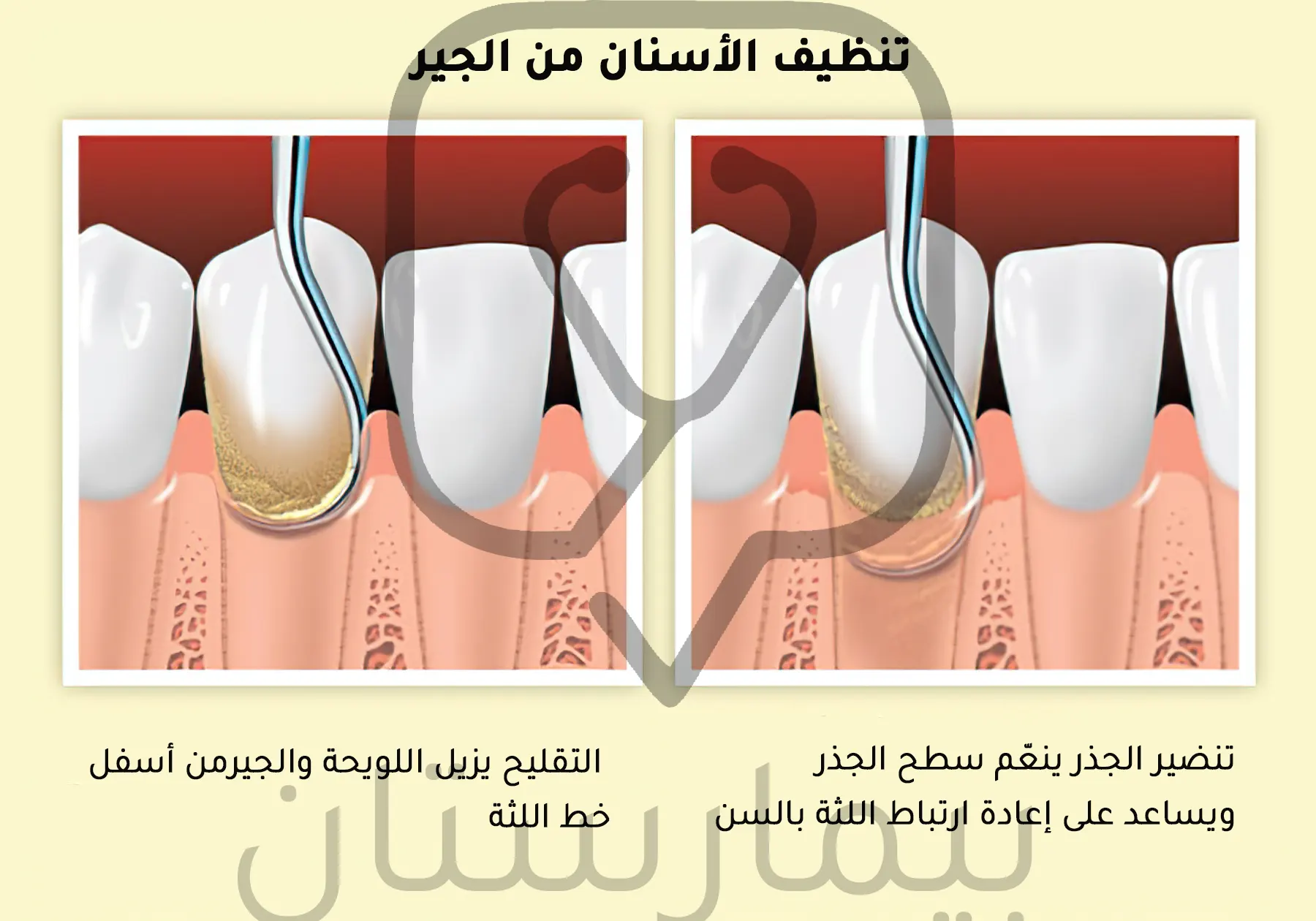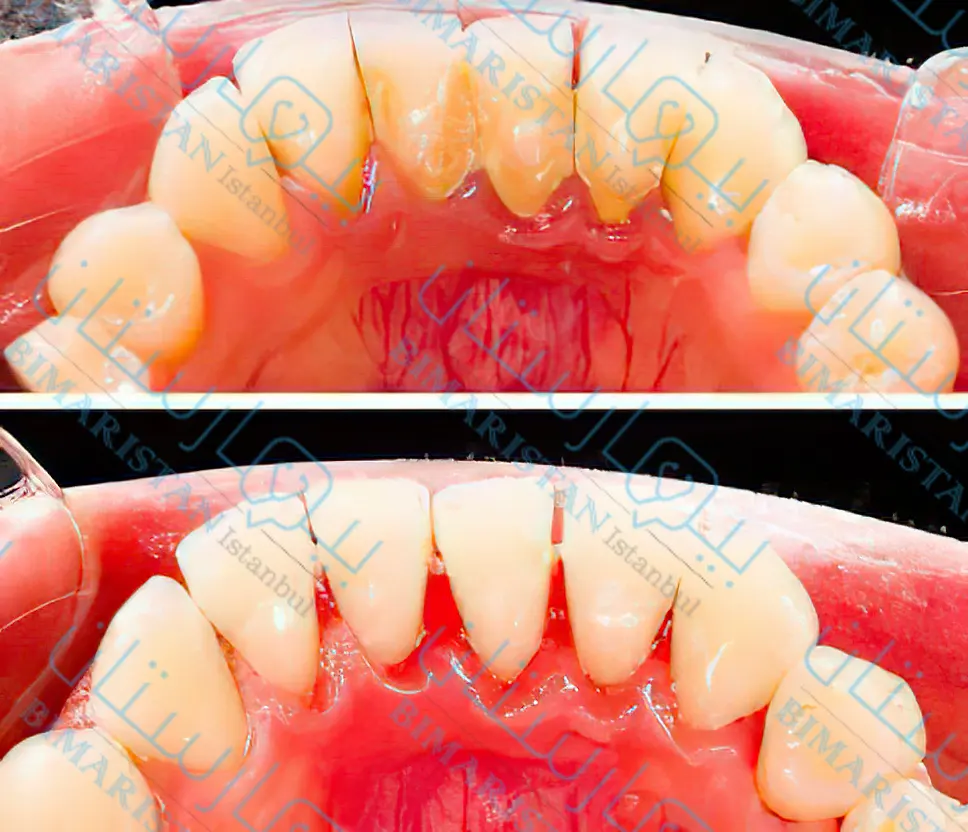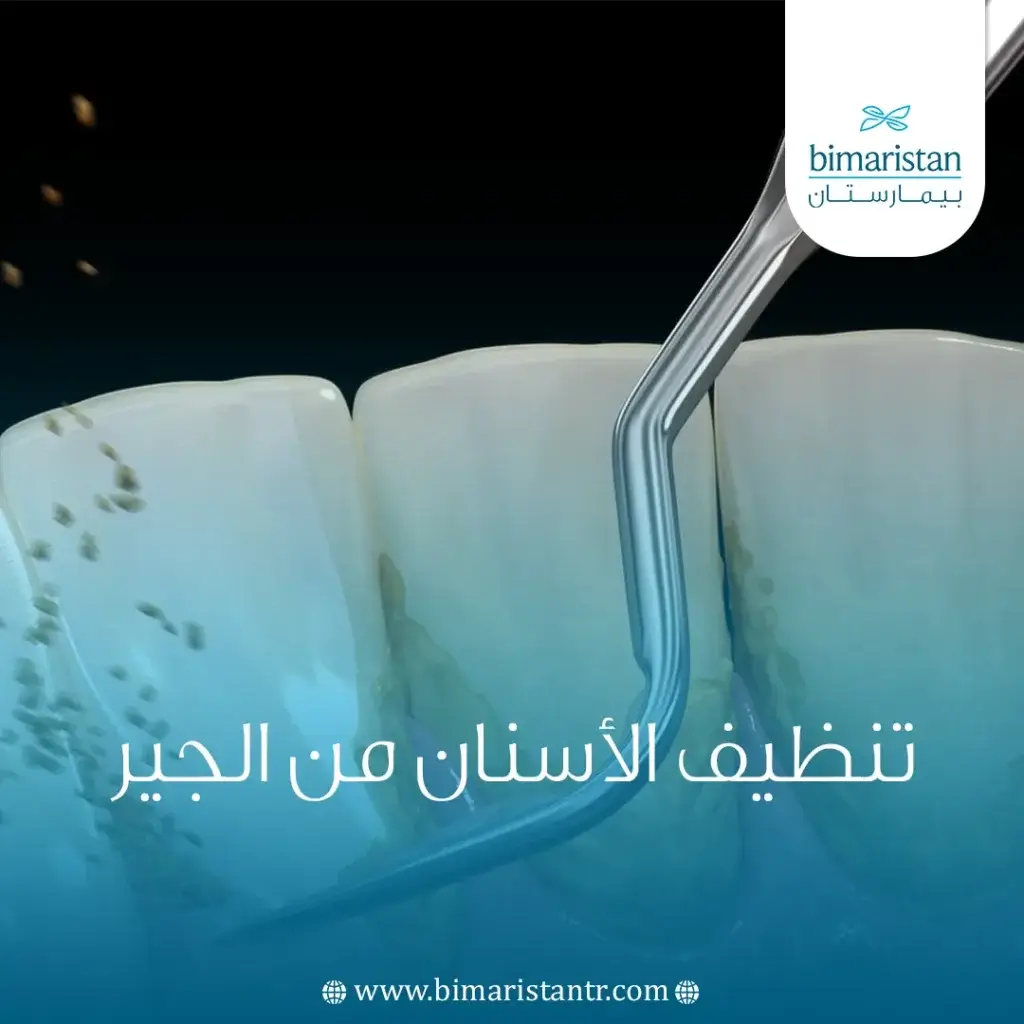تنظيف الأسنان من الجير والذي يطلق عليه اسم تقليح الاسنان وتنضير الجذور يعتبر من الإجراءات الشائعة جداً في طب الفم والأسنان التي تتم في العيادة.
يتم فيها إجراء تنظيف عميق أسفل خط اللثة لعلاج أمراض اللثة والتهاب النسج الداعمة للأسنان والوقاية منها.

فوائد تنظيف الأسنان من الجير
يجب أن يتم تنظيف الأسنان بشكل دوري في عيادة طبيب الأسنان من أجل العلاج والوقاية من التهابات اللثة والنسج الداعمة المحيطة بها التي تتطور نتيجة تراكم الجير في معظم الحالات وتؤدي إلى فقدان الأسنان.
تعتبر عمليات التنظيف الروتينية مهمة للمساعدة في الحفاظ على صحة الفم الجيدة والوقاية من أمراض اللثة.
حتى مع تنظيف الأسنان بالفرشاة والخيط يومياً قد تتراكم طبقة البلاك على الأسنان من بقايا الطعام والمشروبات، تساعد عمليات التنظيف الاحترافية عند الطبيب على إزالة هذا التراكمات.
إذا تُركت دون علاج يمكن أن تسبب البكتيريا الموجودة في اللويحة أمراض اللثة.
بمرور الوقت نتيجة تراكم الجير على طول خط اللثة سوف يحدث انسحاب وتراجع اللثة عن الأسنان وتشكيل الجيوب.
إذا استمرت الحالة بالتطور دون علاج فإن أنسجة اللثة تصبح فضفاضة مما يؤهب لفقدان الأسنان.
لذا فإن الهدف من إجراء تقليح ووتنظيف الأسنان هو إزالة البلاك الموجودة تحت خط اللثة ومساعدة اللثة على العودة إلى حالتها الصحية.
دور جير الأسنان في حدوث أمراض اللثة
التهاب اللثة هو حالة إنتان أو التهاب تنتج غالباً عن البكتيريا الموجودة داخل طبقة اللويحة أو البلاك، وهي الطبقة الملتصقة الحاملة للبكتيريا والتي تتشكل باستمرار على سطح الأسنان.
عند تراكم اللويحة الحاملة للبكتيريا على الأسنان يمكن أن تتحول إلى جير أو ما يسمى بقلح الأسنان، يمكن لهذه الطبقة من البكتيريا أن تجعل اللثة تبتعد عن الأسنان وتشكل فراغات تسمى الجيوب مما يجعل تنظيفها بواسطة فرشاة الأسنان في المنزل أمراً صعباً وغير ممكن.
المرحلة المبكرة من مرض اللثة تسمى التهاب اللثة، عند الإصابة بالتهاب اللثة قد تصبح اللثة حمراء ومتورمة وتنزف بسهولة.
في هذه المرحلة يكون المرض ردوداً ويمكن السيطرة عليه عادةً عن طريق القيام بتنظيف متخصص في عيادة الأسنان مع الاستمرار بتنظيف الأسنان بالفرشاة والخيط يومياً.
إذا تُرك التهاب اللثة دون علاج يمكن أن يؤدي إلى تلف الأنسجة وفقدان العظام الداعمة للأسنان وحينها ندعوه بالتهاب دواعم السن أو التهاب النسج الداعمة الذي يصبح أكثر حدة بمرور الوقت.
إذا حدث ذلك قد تظهر حركة في الأسنان وهي الشكل الأكثر شيوعاً لالتهاب النسج الداعمة للأسنان عند البالغين، والذي يمكن أن يحدث في أي عمر وعادة ما يسوء ببطء ولكن يمكن أن تكون هناك فترات من التقدم السريع.
وجدت دراسة نشرت في مجلة الجمعية الأمريكية لطب الأسنان أن تنظيف الاسنان من الجير عند الطبيب مفيد للمرضى الذين يعانون من التهاب النسج الداعمة المزمن.
أمراض اللثة والنسج الداعمة المحيطة بالأسنان
تكمن خطورة أمراض النسج حول السنية بكونها السبب رئيسي لفقدان الأسنان عند البالغين، وتكون نتيجة تطور التهاب اللثة إلى حالة شديدة تؤثر على النسج الأخرى المحيطة بالسن من عظام وأربطة.
ونظراً لأن أمراض اللثة عادة ما تكون غير مؤلمة لذا فقد لا يعرف الشخص أنه مصاب بها، فيما يلي بعض العلامات التحذيرية التي يمكن أن تشير إلى وجود مشكلة ما في اللثة:
- اللثة تنزف بسهولة
- اللثة حمراء منتفخة وملساء
- اللثة مبتعدة عن الأسنان
- رائحة فم كريهة مستمرة أو الشعور بطعم سيئ
- أسنان دائمة مفقودة أو مفككة
- أي تغيير في الطريقة التي تنطبق بها الأسنان معاً عند العض
- عدم ملاءمة أطقم الأسنان الجزئية
تزيد بعض العوامل من خطر الإصابة بأمراض اللثة مثل:
- الصحة الفموية السيئة
- التدخين أو مضغ التبغ
- العامل الوراثي
- الأسنان سيئة التوضع التي يصعب تنظيفها
- الحمل
- داء السكري
- بعض الأدوية كالستيروئيدات وأنواع معينة من الأدوية المضادة للصرع وأدوية علاج السرطان وبعض حاصرات قنوات الكالسيوم وموانع الحمل الفموية
ما هو تنظيف الأسنان من الجير؟
تقليح اللثة وتنضير الجذر عبارة عن إجراء روتيني يعتمد على القيام بتنظيف عميق غير جراحي للأسنان لكشط الجير باستخدام أحد الطريقتين إما الأدوات اليدوية أو جهاز تنظيف فوق الصوتي في عيادة طبيب الأسنان.
حيث يتم الوصول إلى وإزالة تراكم الترسبات المتكلسة الذي تجمعت أسفل خط اللثة على طول الجزء السفلي من التاج السريري للأسنان والتي لم تستطع فرشاة أسنانك الوصول إليها.
عادة ما يقوم أطباء الأسنان بعملية إزالة الجير من الأسنان عن طريق تقليح الأسنان وتنضير الجذور كخطوة أولى في علاج أمراض اللثة.
يساعد التنظيف العميق باستخدام أجهزة الأمواج فوق الصوتية او التنظيف اليدوي العميق بالأدوات المحمولة باليد في الوصول إلى نتائج سريرية مرضية ولكن التنظيف بالموجات فوق الصوتية أسرع ويستغرق وقتاً أقل بنسبة 20٪ إلى 50٪ من التنظيف اليدوي.
جهاز التنظيف بالموجات فوق الصوتية له قبضة لها طرف معدني مدمج مع رذاذ الماء يهتز بتردد منخفض، يساعد اهتزاز الطرف على تفتيت الجير بينما يقوم الماء بإزالة البقايا بعيداً.
ماذا يحدث أثناء تنظيف الأسنان من الجير في العيادة؟
يتألف هذا التنظيف العميق من جزأين، التقليح عندما يزيل طبيب الأسنان كل طبقة الجير أو القلح واللويحة (اللويحة المتصلبة) أعلى وأسفل مستوى اللثة، مع التأكد من التنظيف بالكامل حتى عمق الجيب.
سيبدأ طبيب الأسنان بعد ذلك في تنضير وتنعيم جذور الأسنان لمساعدة لثتك على إعادة الالتصاق بالأسنان.

كيف يتم تنظيف الأسنان من الجير؟
قد يقوم طبيب الأسنان أولاً بوضع مخدر موضعي لتخدير المنطقة التي سيعمل فيها في فمك.
سيقوم طبيب الأسنان بكشط كل اللويحة والجير من الأسنان – تقليح – فوق وتحت خط اللثة وصولاً إلى الجيب اللثوي.
بعد إزالة لويحة الأسنان أو طبقة القلح، سيقوم طبيب الأسنان بتنضير أو تكييف الأسطح الخشنة على جذور الأسنان مما سيساعد اللثة على إعادة الالتصاق بالأسنان.
اعتماداً على حالتك قد تستغرق عملية تنظيف أسنان عند الطبيب أكثر من زيارة واحدة لعيادة الأسنان، بعد هذا العلاج قد تحتاج إلى زيارات لمتابعة الحالة.
ما مدى فعالية تنظيف الأسنان من الجير في العيادة؟
معظم حالات أمراض اللثة المزمنة يتم التحكم بها بنجاح عن طريق إزالة الجير والبكتيريا أثناء تنظيف الأسنان لكن قد تؤثر بعض العوامل على كيفية استجابة الأسنان للعلاج، مثل:
- داء السكري
- التدخين
- تضرر الأسنان مما يؤدي إلى اختلال السوية
نصائح بعد تنظيف الاسنان من الجير
- بعد عملية تنظيف الأسنان عند الطبيب، قد تشعر بالألم لمدة يوم أو يومين، تزيد حساسية الأسنان لمدة تصل إلى أسبوع قد تتورم لثتك أيضاً وتشعر بألم ونزيف.
- لمنع الإنتان أو السيطرة على الألم ومساعدتك على الشفاء، قد يصف لك طبيب الأسنان حبوباً أو غسولاً للفم.
- قد يقوم طبيب الأسنان أيضاً بتطبيق دواء (جرعة دوكسي سيكلين دون مضادات الميكروبات) مباشرة في الجيب الذي تم تنظيفه.
- سيحدد طبيب الأسنان زيارة أخرى ليرى كيف تعافت لثتك ويقيس عمق جيوبك، إذا أصبحوا أعمق فقد تكون هناك حاجة إلى جلسة تنظيف ومزيد من العلاج.
- من الممكن في بعض الأحيان أن يحصل التهاب اللثة بدون ظهور علامات تحذيرية، وهنا تأتي أهمية الفحوصات الدورية عند طبيب الأسنان، خطة العلاج تعتمد على نوع المرض ودرجة تطور الحالة.
- لتنظيف الأسنان والعناية الفموية الجيدة في المنزل دور جوهري في الحفاظ على نتائج العلاج ومنع تراكم الجير وبالتالي التخلص من مشاكل اللثة في المستقبل.
تذكر: عليك أن تحذر من فقد أسنانك بسبب أمراض اللثة، راجع طبيب الأسنان إذا كنت تشك في إصابتك بأمراض اللثة لأنه كلما أسرعت في علاجها كان ذلك أفضل.
حافظ على نظافة وصحة الأسنان الخاصة بك، استخدم الفرشاة و معجون الأسنان بانتظام مرتين في اليوم لمدة دقيقتين ونظف ما بين أسنانك باستخدام خيط أسنان مرة يومياً للتخلص من طبقات اللويحة وبقايا الطعام.
اتبع نظاماً غذائياً متوازناً وتجنب استخدام التبغ وحدد مواعيد منتظمة لزيارات طبيب الأسنان وذلك للحفاظ على ابتسامة صحية لأطول مدة ممكنة.

